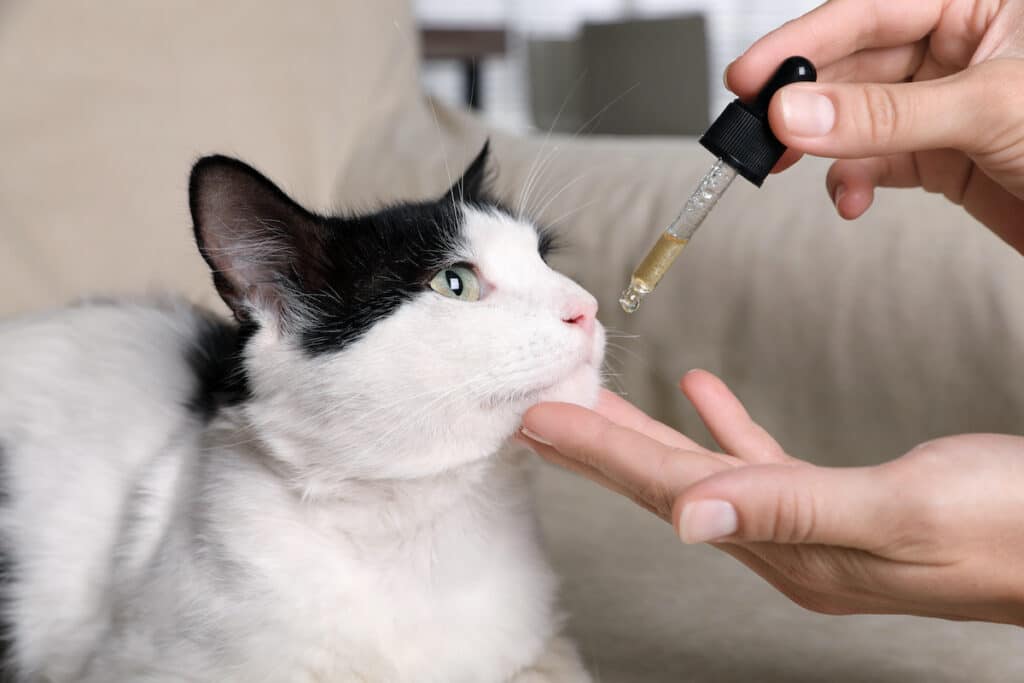Sometimes you have to give your cat liquid medicine due to an infection or health reason. The syringe used to deliver medications is not an exception to the rule that cats typically struggle and resist being forced to swallow things. Giving your cat liquid medication, however, doesn’t have to be difficult with a little bit of planning and by according to a few straightforward guidelines.
Preparing to give your cat liquid medicine
Position your cat.
Make sure your voice is pleasant, joyful, and relaxed as you carry your cat to the towel-covered dosing location. Put the cat facing you in the center of the towel.
Immobilize the cat.
You must now make sure that the cat cannot move or flee while the medication is being administered. It might be enough to contain it if your cat is exceptionally calm. If you have a helper, ask them to gently hold the cat’s top forelegs while placing a hand on either of its shoulders. This prevents the cat from lifting its front paw to scratch and keeps it immobile. To prevent the cat from backing away or writhing sideways, you or the assistance can also hold the cat close to your chest or stomach.
You must wrap your cat in the towel if it is wiggly or inclined to scratch you. Wrap your cat tightly, allowing only its head to protrude. The claws are safely confined inside and cannot scratch you thanks to the tight fit around the neck. Fold one half of the towel over the cat’s back and then do the same with the other half to enclose the cat in the towel. Fill in any gaps in the towel over its neck to press its front legs against its body and keep it enclosed. If you have a helper, ask them to place their hands on the towel’s outside, across the cat’s shoulders, to balance the pet.
Open the cat’s mouth. With your left hand’s fingers and thumb, create an inverted “C” form. Put the cat’s head over this upside-down C. Your palm should be on the cat’s forehead, your fingertip and thumb should be on either side of the cat’s jaw corner. Gently press the cat’s upper lips over its upper cheek teeth by using your fingertip and thumb to gently press inward (the molars).
If you are a left-handed person, open the cat’s mouth with your right hand so that you can administer the medication with your left hand. This method reduces the possibility that you will get bitten while also forcing the cat to extend its lips just a little bit to prevent biting its own lip.
Raise the cat’s head.
The cat should tilt its head upward and toward the ceiling once it has slightly opened its jaws. You can achieve this by simply rotating your wrist without changing your left-hand grip. The lower jaw helps open the mouth wider by a slight downward tilt of the head.
How to Give Your Cat Liquid Medicine
Place the syringe in the cat’s mouth. Take the syringe in your free hand and place the open end of it with the hub inclined over the cat’s tongue, just above the lower fangs (the long teeth at the front of the lower jaw). The syringe’s tip should ideally be able to brush against the cat’s molars.
Begin giving your cat liquid medicine.
Press the syringe’s plunger slowly and gently until roughly half a milliliter of fluid drips into the cat’s mouth. The cat will move its tongue and make an attempt to swallow once you have placed medicine in its mouth. You might need to loosen up your wrist so that she can lower her head to a more natural position for swallowing because some cats like to do so.
Finish giving your cat the liquid medicine.
Give the cat another half milliliter of the medication after it has had a chance to swallow. Once you have administered the entire prescribed dose, repeat this procedure.
Reward your cat.
You slowly unfold the towel while soothingly speaking to the animal. The cat will probably flee as quickly as possible, but if not, show it some love and possibly give it a good treat. Rewarding the cat after administering medication will lessen its anger and make the procedure simpler the following time. Homemade or store bought treats are sure to please.














